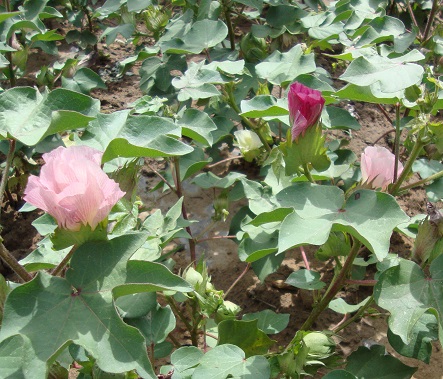

Effect of Cluster Planting Pattern on Intraspecific Interactions of Cotton
? These authors contributed equally to this paper
Received date: 2013-12-02
Accepted date: 2014-04-03
Online published: 2015-04-09
We aimed to investigate the effect of a cluster-planting pattern on intraspecific interactions and test whether cluster planting can modify the type and intensity of intraspecific interactions, thus increasing yield. The growth characteristics of different organs of cotton under cluster and traditional planting patterns were studied and the effect of different hole distances on intraspecific interactions were analyzed. As compared with the traditional planting pattern of one plant in a hole, with cluster planting, the stem growth was reduced significantly, along with decreased hole distance, but the leaf growth and yield was highest with 28 cm hole distance. Moreover, different hole distances significantly affected the relative neighbor effect (RNE): the stem RNE increased then decreased with decreasing hole distance, but the values were all negative and the intensity of the negative effect was minimal with the 28 cm hole distance. Leaf and yield RNE were posi- tive and the intensity of the positive effect was maximal with the 28 cm hole distance. Cluster planting may effect intraspecific interactions. This facilitation is maximal for yield of cotton with the 28 cm hole distance.

Tingting Xie , Zijuan Zhou , Shanjia Li , Peixi Su , Lishan Shan . Effect of Cluster Planting Pattern on Intraspecific Interactions of Cotton[J]. Chinese Bulletin of Botany, 2015 , 50(1) : 83 -89 . DOI: 10.3724/SP.J.1259.2015.00083
| 1 | 李博, 陈家宽, 沃金森AR (1998). 植物竞争研究进展. 植物学通报 15(4), 18-29. |
| 2 | 苏培玺, 杜明武, 赵爱芬, 张小军 (2002). 荒漠绿洲主要作物及不同种植方式需水规律研究. 干旱地区农业研究 20(2), 79-85. |
| 3 | 苏培玺, 解婷婷, 丁松爽 (2009). 河西走廊绿洲棉花集群高产栽培试验研究. 干旱地区农业研究 27(6), 108-113. |
| 4 | 吴开贤, 安瞳昕, 范志伟, 周锋, 薛国峰, 吴伯志 (2012). 土壤氮异质性与种间地上竞争对玉米和马铃薯生长的影响. 中国生态农业学报 20, 1571-1578. |
| 5 | 于国磊 (2011). 水淹对克隆植物空心莲子草种内关系的影响. 植物生态学报 35, 973-980. |
| 6 | Bertness MD (1989). Intraspecific competition and facilitation in a northern acorn barnacle population.Ecology 70, 257-268. |
| 7 | Bertness MD, Callaway RM (1994). Positive interactions in communities.Trends Ecol Evol 9, 191-193. |
| 8 | Bertness MD, Ewanchuk PJ (2002). Latitudinal and climate-driven variation in the strength and nature of biological interactions in New England salt marshes.Oe- cologia 132, 392-401. |
| 9 | Bertness MD, Hacker SD (1994). Physical stress and positive associations among marsh plants.Am Nat 144, 363-372. |
| 10 | Bertness MD, Yeh SM (1994). Cooperative and competitive interactions in the recruitment of marsh elders. Ecology 75, 2416-2429. |
| 11 | Bosse U, Frenzel P (1997). Activity and distribution of methane-oxidizing bacteria in flooded rice soil microcosms and in rice plants (Oryza sativa).Appl Environ Microb 63, 1199-1207. |
| 12 | Bruno JF, Stachowicz JJ, Bertness MD (2003). Inclusion of facilitation into ecological theory.Trends Ecol Evol 18, 119-125. |
| 13 | Buttery BR, Williams WT, Lambert JM (1965). Competition between Glyceria maxima and Phragmites communis in the region of Surlingham Broad. II. The fen gradient.J Ecol 53, 183-195. |
| 14 | Callaway RM (2007). Positive Interactions and Interdependence in Plant Communities. Dordrecht: Springer. |
| 15 | Callaway RM, Walker LR (1997). Competition and facilitation: a synthetic approach to interactions in plant communi- ties.Ecology 78, 1958-1965. |
| 16 | Cavieres LA, Sierra-Almeida A (2012). Facilitative interactions do not wane with warming at high elevations in the Andes.Oecologia 170, 575-584. |
| 17 | Crain CM (2008). Interactions between marsh plant species vary in direction and strength depending on environmental and consumer context.J Ecol 96, 166-173. |
| 18 | DeAngelis DL, Post WM, Travis CC (1986). Positive Feedback in Natural Systems. Berlin: Springer. |
| 19 | Jiang HH, Kong FX, Gu XZ, Chen KN, Zhao SW, Wang J (2010). Influence of intraspecific interaction and substrate type on initial growth and establishment of Hydrilla verticillata.Hydrobiologia 649, 255-265. |
| 20 | Kikvidze Z, Khetsuriani L, Kikodze D, Callaway RM (2006). Seasonal shifts in competition and facilitation in subalpine plant communities of the central Caucasus.J Veg Sci 17, 77-82. |
| 21 | Kitzberger T, Steinaker DF, Veblen TT (2000). Effects of climatic variability on facilitation of tree establishment in northern Patagonia.Ecology 81, 1914-1924. |
| 22 | Li PX, Krüsi BO, Li SL, Cai XH, Yu FH (2011a). Can Potentilla fruticosa Linn. shrubs facilitate the herb layer of heavily grazed pasture on the eastern Tibetan Plateau?Pol J Ecol 59, 135-146. |
| 23 | Li PX, Krüsi BO, Li SL, Cai XH, Yu FH (2011b). Facilitation associated with three contrasting shrub species in heavily grazed pastures on the eastern Tibetan Plateau.Community Ecol 12, 1-8. |
| 24 | Luo WB, Xie YH, Chen XS, Li F, Qin XY (2010). Competition and facilitation in three marsh plants in response to a water-level gradient.Wetlands 30, 525-530. |
| 25 | Maestre FT, Cortina J (2004). Do positive interactions increase with abiotic stress? A test from a semi-arid steppe.Proc Biol Sci 271, S331-S333. |
| 26 | Maestre FT, Valladares F, Reynolds JF (2005). Is the change of plant-plant interactions with abiotic stress predictable? A meta-analysis of field results in arid environments. J Ecol 93, 748-757. |
| 27 | Visser EJW, Colmer TD, Blom CWPM, Voesenek LACJ (2000). Changes in growth, porosity, and radial oxygen loss from adventitious roots of selected mono- and dicotyledonous wetland species with contrasting types of aerenchyma.Plant Cell Environ 23, 1237-1245. |
| 28 | Wang LW, Showalter AM, Ungar IA (2005). Effects of intraspecific competition on growth and photosynthesis of Atriplex prostrata.Aquat Bot 83, 187-192. |
| 29 | Wilson JB, Agnew ADQ (1992). Positive-feedback swit- ches in plant communities.Adv Ecol Res 23, 263-336. |
| 30 | Yu FH, Li PX, Li SL, He WM (2010). Kobresia tibetica tussocks facilitate plant species inside them and increase diversity and reproduction.Basic Appl Ecol 11, 743-751. |
/
| 〈 |
|
〉 |